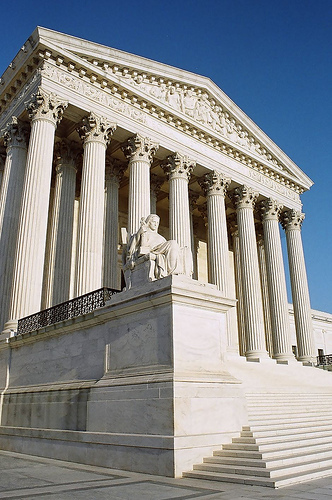Fisher v. Texas: A View of Affirmative Action from Brazil

 By Tanya K. Hernandez, New America Media
By Tanya K. Hernandez, New America Media
The October 10, 2012, Supreme Court argument in the Fisher v. Texas affirmative action case marks a peculiar turning point in the racial history of the United States and its inspiration in worldwide civil rights movements. Just as the United States Supreme Court reconsiders the constitutionality of race based affirmative action programs in higher education, Latin American countries such as Brazil are actively adopting nationwide affirmative action policies. The Brazilian context can provide the Supreme Court with useful guidance in comprehending the continued importance of affirmative action in pursuing racial equality.
Indeed, the affirmative action challenge to the University of Texas at Austin’s use of race in itsundergraduate admissions decisions, makes a sharp contrast to the Brazilian Supreme Court’s unanimous endorsement of affirmative action just this past April when it declared that the Federal University of Brasilia’s affirmative action program was not only constitutional but an important duty and social responsibility of the nation-state in its enforcement of equality. After this historic decision was issued, Brazilian legislators enacted the “Law of Social Quotas.”
 As of August 29, 2012, the new law requires public universities to reserve half of all new admission spots for Brazilian public school students (many of whom are African-descendants). In addition, the law requires that 50% of those spots be reserved for African-descendants and persons of indigenous ancestry in numbers proportional to their relative populations within each state. Of the 81 senators representing Brazil’s 26 states, only one voted against the bill.
As of August 29, 2012, the new law requires public universities to reserve half of all new admission spots for Brazilian public school students (many of whom are African-descendants). In addition, the law requires that 50% of those spots be reserved for African-descendants and persons of indigenous ancestry in numbers proportional to their relative populations within each state. Of the 81 senators representing Brazil’s 26 states, only one voted against the bill.
In contrast to Brazil’s new broadly encompassing embrace of affirmative action, the United States Supreme Court is now considering a challenge to even the most meager of race-conscious considerations. Most students at the University of Texas at Austin are admitted under a state law (the “Top Ten Percent Plan”), which requires the university to admit all Texas residents who rank in the top ten percent of their high school class. For the remainder of the class, UT undertakes a holistic “whole-file” review of applications. This process allows the school to consider additional criteria, such as essays, leadership qualities, extracurricular activities, awards, work experience, community service, family responsibilities, socio-economic status, languages spoken in the home, and-as of 2005-race. It is this modest consideration of race alongside a host of other factors that is now at issue in the Supreme Court.
What accounts for this divergence in national perspectives across the Americas?
In some respects the racial justice movement in the United States is a victim of its own past success. While the formal mechanisms for addressing racial inequality have long been in place, there is a growing societal belief that it is no longer necessary for the government to be proactively engaged in ensuring racial equality. A racial hierarchy continues to exist alongside a deteriorated social commitment to race-based programs.
The early U.S. civil rights movement was astonishingly successful at making the goal of racial equality a stated national norm and catalyzing government programs designed to provide concrete access to jobs and education. However, the movement’s very success contributes to the notion that blacks and other persons of color no longer require legal assistance in accessing equal opportunity.
Indeed, President Obama’s election in 2008 is viewed as the culmination of U.S. racial transcendence, so that now the United States presents itself as “racially innocent ” in much the same way Latin America has long claimed to be because of its absence of official Jim Crow laws of racial segregation. At the same time, systemic racism has not been eradicated in the United States, as evidenced by the long-standing institutional racial disparities in employment, educational attainment, access to health care and capital, residential segregation, and disparate incarceration and execution rates.
The approximately 150 million people of African descent in Latin America have long been plagued by similar experiences of systemic racism and social exclusion. While African-descendants represent about one-third of the total population in Latin America they make up 40 percent of the poor and have been consistently marginalized and denigrated as undesirable elements of the society since the abolition of slavery. Because Latin America is a region that has long claimed that all racial distinctions were abandoned with the abolition of slavery, a U.S. comparison to the Latin American racial democracy version of “postracialism ” is an instructive platform from which to assess the viability of contemporary assertions of postracialism in the United States – a rhetoric that contends that racism has already been largely transcended.
As the longtime scholar of comparative race relations Anani Dzidzienyo notes, examining the Latin American racial context “can provide insights for Afro-Americans who are today having to confront the mainstream’s assumptions concerning ‘the end of racism’ in a post-Civil Rights U.S. society.” It should thus be quite instructive to observe that Brazil’s recent Supreme Court endorsement of race based affirmative action was rooted in the perception of the state as having a duty to guarantee the “conditions of equality” for groups that have historically lived on the margins of society, enabling them to fully exercise their human rights and fundamental rights.
Tanya K. Hernandez, Professor of Law Fordham Univ. School of Law and author of “Racial Subordination in Latin America: The Role of the State, Customary Law, and the New Civil Rights Response” (Cambridge Univ. Press) https://sites.google.com/site/racismlatam/.
This article was originally published by SALTLAW Blog (Society of American Law Teachers) on Oct. 9, 2012. It is reprinted on NAM with permission.
[Photo by yeowatzup]
